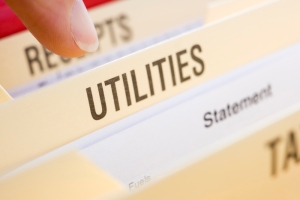
When it comes to managing money, misinformation is everywhere. From outdated advice to widely believed myths, these misconceptions can make it harder to reach your financial goals. At First Financial, we’re here to help you navigate your finances with confidence. Let’s clear up some of the most common money myths and set the record straight.
Myth #1: Debit is Always Better Than Credit
While debit cards can help prevent overspending, credit cards – when used responsibly, have their unique benefits. With a good credit card, you can earn rewards, build your credit history, and even get purchase protection. Read up on when it’s best to use cash, credit or debit in our blog post about this topic.
Our Visa® Cash Plus Credit Cards offer cash back and uChoose Rewards that can be redeemed for merchandise, gift cards, and more.* Using a credit card for everyday purchases while paying off your balance in full each month — can improve your credit score and help you qualify for better loan terms in the future.
Myth #2: Buying a Home is Always Better Than Renting
Homeownership is often seen as the ultimate financial milestone, but it’s not always the right choice for everyone. Buying a home comes with long-term responsibilities, maintenance costs, and upfront expenses like closing costs and property taxes. You can learn more about this in our recent blog post on the true cost of homeownership.
If you prefer flexibility, aren’t ready for the commitment, or live in an area where renting is more affordable – renting might be the smarter choice for your current lifestyle. Owning a home can be a great investment, but it’s not a one-size-fits-all solution. Schedule a phone call or video chat with a First Financial mortgage expert to help decide what’s right for you.**
Myth #3: My Partner Manages the Finances, So I Don’t Need to
It’s okay for one person to take the lead on budgeting and bills, but all adults in a household should be financially informed. Whether you’re married, in a long-term partnership, or living with roommates – understanding your household’s finances is essential.
Life can change in an instant. If something happens to your partner or the financial leader of the home, you need to be prepared to manage accounts, pay bills, and make smart financial decisions. Financial literacy is a shared responsibility. Check out our financial tools and publications to help yourself prepare to manage your household budget.
Myth #4: I Can Rely on Credit Cards for Emergencies
While credit cards can bridge short-term gaps, they’re not a reliable plan for true emergencies like a job loss or a medical crisis. Interest and other fees can quickly turn your emergency into overwhelming debt. Instead, build an emergency savings fund with 3–6 months’ of essential expenses. This safety net offers peace of mind and keeps you from relying on high-interest borrowing when the unexpected happens.
Myth #5: Emergency Savings Aren’t That Important
One of the most harmful money myths is that you don’t need emergency savings. This type of account isn’t for vacations or a new car — it’s for life’s curveballs.
Having a separate emergency fund from all other checking and savings accounts ensures you’re financially prepared for unexpected events like car repairs, medical bills, or job loss. It’s not a luxury — it’s a necessity. Start small and build over time; even saving a few dollars a week adds up!
Myth #6: I Make Enough Money — Budgeting Isn’t Necessary
Even if you earn a comfortable income, budgeting is still important. Without a spending plan, it’s easy to lose track of where your money goes — or accidentally overspend.
A clear budget helps you make intentional decisions, prioritize saving, and avoid lifestyle inflation. Use our Home Budget Calculator to track your expenses and identify areas of improvement. Whether you’re saving for a house, planning a vacation, or just trying to live within your means – budgeting helps you stay focused.
Get the Facts with First Financial
Smart financial decisions start with reliable information. We’re here to help you build habits that support your financial well-being, and that are free from myths and misinformation. Call us at 732.312.1500 or visit your local branch to learn more. Don’t forget to subscribe to our First Scoop Blog for ongoing financial resources and ideas.
*Your First Financial Visa® Cash Plus Credit Card will earn cash back based on your eligible purchase transactions. The cash back will be applied to your current credit card balance on a quarterly basis and be shown cumulatively on your billing statement. Unless you are participating in a limited time promotional offer, you will earn 1% cash back based upon eligible purchases each quarter. APR varies up to 18%, when you open your account based on your credit worthiness. This APR is for purchases and will vary with the market based on the Prime Rate. Subject to credit approval. Rates quoted assume excellent borrower credit history. Your actual APR may vary based on your state of residence, approved loan amount, applicable discounts and your credit history. No Annual Fees. Other fees that apply: Balance Transfer and Cash Advance Fees of 3% or $10, whichever is greater; Late Payment Fee of $29, $10 Card Replacement Fee, and Returned Payment Fee of $29. A First Financial membership is required to obtain a Visa® Credit Card and is available to anyone who lives, works, worships, volunteers, or attends school in Monmouth or Ocean Counties.
**APR = Annual Percentage Rate. Subject to credit approval. Credit worthiness determines your APR. Rates quoted assume excellent borrower credit history and are for qualified borrowers. Your actual APR may vary based on your state of residence, approved loan amount, applicable discounts and your credit history. Higher rates may apply depending on terms of loan and credit worthiness. Minimum mortgage loan amount is $100,000. Available on primary residence only. The Interest Rates, Annual Percentage Rate (APR), and fees are based on current market rates, are for informational purposes only. Rates and APRs listed are based on a mortgage loan amount of $250,000. Mortgage insurance may be required depending on loan guidelines. This is not a credit decision or a commitment to lend. If mortgage insurance is required, the mortgage insurance premium could increase the APR and the monthly mortgage payment. See Credit Union for details. A First Financial membership is required to obtain a Mortgage and is open to anyone who lives, works, worships, volunteers, or attends school in Monmouth or Ocean Counties. Standard text messaging and data rates may apply.
 A financial check-up is like an annual physical in that it can help you catch problems early, adjust to life changes, and set yourself up for a healthier future. Whether you live with family, a partner, or roommates – reviewing your money together builds trust and alignment.
A financial check-up is like an annual physical in that it can help you catch problems early, adjust to life changes, and set yourself up for a healthier future. Whether you live with family, a partner, or roommates – reviewing your money together builds trust and alignment.




